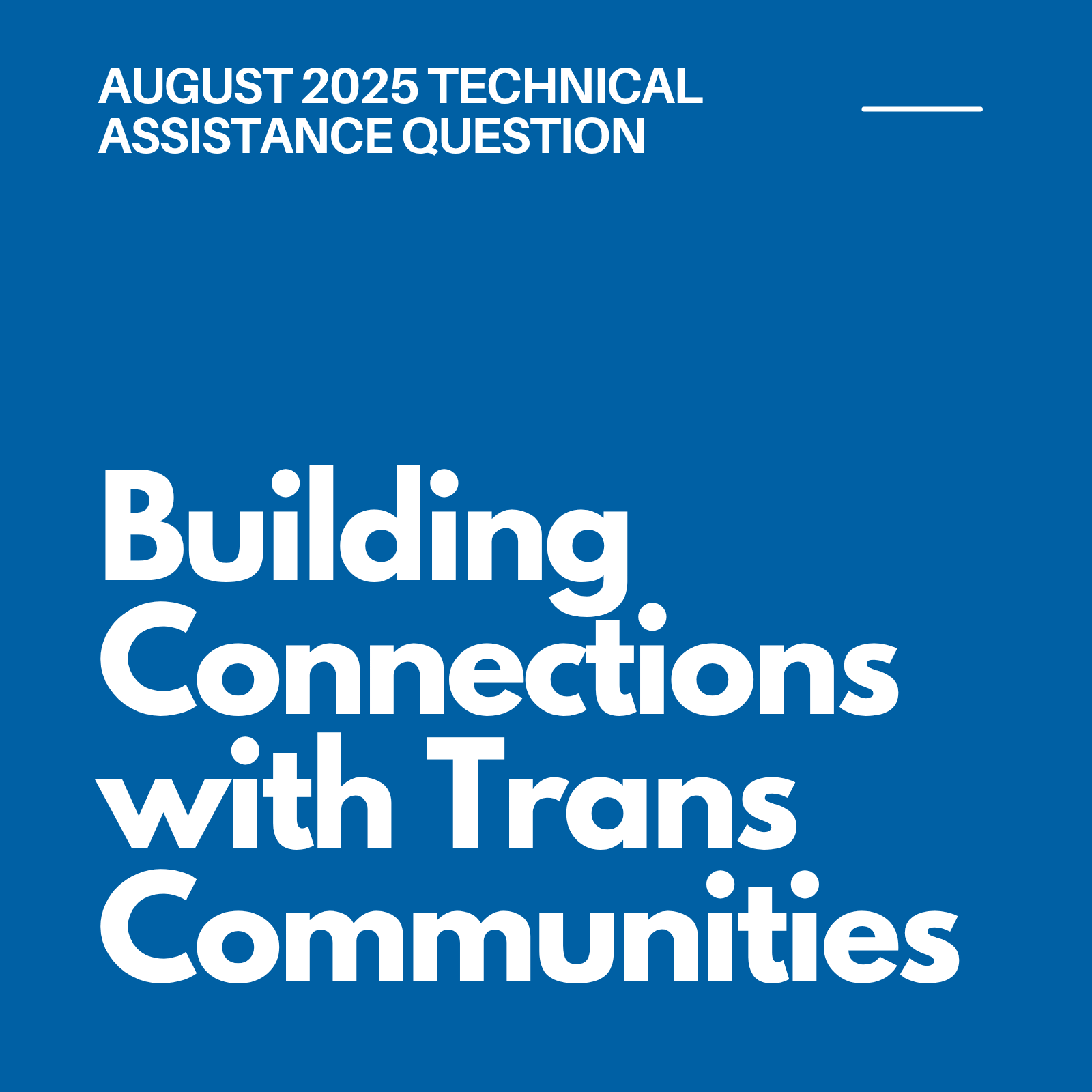Question
“My agency has done a lot of work to update all of our forms to be trans inclusive. We train staff to ask for and use pronouns, and we share ours. We’ve changed the décor in our main offices, updated our bathroom signs, and changed our description on our website. Now we specifically say that transgender and nonbinary people are welcome.
The problem is that we still aren’t seeing any transgender people come in for services. Or at least no one has told us that they are trans. What are we doing wrong?”
Answer
Congratulations on all of the work your organization has done so far. These changes make services better for everyone and model inclusivity. That matters.
You are not alone in this situation. It’s very common that mainstream agencies (those that are not culturally-specific or -focused) struggle to build strong trusting relationships with various communities. It can take time for word to spread that an organization is well-equipped to provide trans-affirming services. There are things that we can do to build trust during this time. Consider these questions to continue your outreach, connection, and service to trans survivors:
- What is your agency’s reputation within the trans/nonbinary and LGBTQ+ communities in your area?
- This may require some research to find out. Ask people. Do internet searches. Ask some more people. If there was a past negative experience that survivors had, it can take a long time for survivors to trust you again.
- You may need to do work as an agency to heal if there is a rift or past harm. This may look like listening sessions, mediation, or an apology and changed behavior.
- If trans people have had positive experiences with your agency, what can you learn from them? How can these positive interactions guide your agency’s actions? Are there ethical ways to share this information with other trans community members – such as including a quote in a newsletter or on social media? (Always ensure you have a survivor’s permission for this and make sure their privacy is protected.)
- How do survivors find out about your services? Where are trans/nonbinary survivors currently going (if anywhere) for support?
- Community members might be completely unaware of your organization. How do people learn about your agency? Are outreach efforts reaching the populations you want to serve?
- If you haven’t already, assess your outreach efforts. Do you put information in places that trans people go? Do your print materials – posters, pamphlets, billboards – make it clear that trans/nonbinary people are welcome?
- Talking to trans/nonbinary community members and organizations can help you identify the places and people that trans survivors are going to for support. Then you can connect with those places. For example, often trans folks may call an LGBTQ+ center rather than a domestic violence agency. In some areas there are only one or two therapists and physicians that are respected within the trans community. Once you identify who these individuals are, you can share information with them and work together to best support trans survivors.
- Consider increasing or changing community education efforts. Many trans/nonbinary survivors report they only talk to friends and family. By sharing information with LGBTQ+ affirming community members about your services, you are increasing the number of supportive community members that exist.
- Are you going to where trans folks are? This may include tabling at Pride events in June, drag nights at a local bar, or attending a fundraiser for a local trans/LGBTQ+ organization. This may look like partnering with gender affirming care clinics or local LGBTQ+ businesses. Showing up for trans community events is a good way to build trust.
- Not all events and organizations will be very publicly advertised. It may take connections within the community to learn about useful places to outreach.
- Are your services relevant to trans/nonbinary survivors?
- It may be helpful to review the services that you offer. Are you able to adapt your services to the unique needs of each survivor? Do staff know how to provide trans-affirming support and understand how to tailor safety planning or advocacy efforts for trans folks?
- Are there barriers to accessing services that could be addressed?
- For example, do people have to show ID or go through security to access a building? Trans people are less likely to have government identification that matches their name/gender, and passing through security may involve harassment or misgendering.
- Trans people also face higher rates of un/underemployment and housing instability. Consider what financial resources it may take for them to access your services. Is there safe transportation to your services? How could being homeless impact someone’s ability to attend an appointment?
- Are there law enforcement or other agencies around that may be less safe for trans people to be near? In a nationwide survey, over 70% of trans people reported discomfort with law enforcement.
- It may be helpful to review the services that you offer. Are you able to adapt your services to the unique needs of each survivor? Do staff know how to provide trans-affirming support and understand how to tailor safety planning or advocacy efforts for trans folks?
It can be disheartening to put a lot of effort into updating your organization and then not see immediate results. Keep at it though! Your work for inclusive services is vital. It makes a huge difference to survivors. Change does take time. It is important that we don’t wait passively for trans survivors to use our services. We can continue to make active efforts to create services available to trans/nonbinary people and communities.

